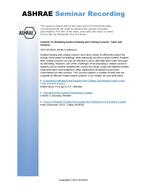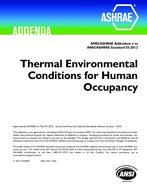A simple two-dimensional (2-D) numerical control volume formulation is presented that can be used to model heat transfer through a vertical insulated glazing unit. This model accounts for natural convection of the fill gas (including the effect of secondary cells), conduction within the solid materials, and radiant exchange between the various surfaces facing the fill-gas cavity. This model closely reproduces average and local heat transfer rates measured using a guarded heater plate apparatus. Simulations clearly show that fill-gas motion causes the minimum indoor surface temperature (during cold weather) to be located at the bottom edge of the indoor glazing. Calculated results were also used to gain insights into heat transfer patterns in glazing systems with various combination of low-emissivity coatings, fill gases, and edge-seal designs.
KEYWORDS: year 1995, calculating, glazing, heat flow, windows, double glazing, surface temperature, indoor, insulating window films, algorithms, models
Citation: Symposium, ASHRAE Trans. 1995, Vol.101, Part 1, Paper number CH-95-1-1, 525-527
Product Details
- Published:
- 1995
- File Size:
- 1 file , 1.3 MB
- Product Code(s):
- D-16862


